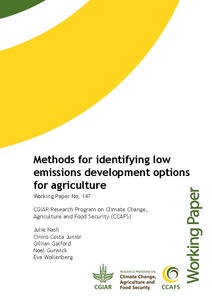
Low emissions  development strategies (LEDS) are national economic and social development plans that promote sustainable development while reducing GHG emissions. While LEDS programs have helped to mainstream economy-wide planning for low emissions, planning for low emissions agriculture has remained nascent. Low-emissions development (LED) in agriculture acknowledges that the primary purpose of agriculture is to produce food and other goods for human needs, and that climate change mitigation is a secondary goal that should not compromise production. This paper describes a research process and protocol to identify high potential LED options in agriculture at the United States Agency for International Development (USAID). The case study illustrates the steps for the identification and prioritization of LED options including: idea generation, concept development, and evidence building. Each stage is designed to gather and analyze data that specifically enable managers and stakeholders to make informed evaluations. The method gathers not only emission and mitigation information but also food security and income generation data, lending process legitimacy to the research. The incorporation of institutional factors and local contextual systems in the LED concept development stage improves the output credibility and salience. In the final process phase, stakeholders are given an active role in determining the criteria for prioritization and building evidence. The LED option identification and prioritization process illustrates how careful evidence-building can increase the credibility and salience of outputs and legitimacy of the overall results.
development strategies (LEDS) are national economic and social development plans that promote sustainable development while reducing GHG emissions. While LEDS programs have helped to mainstream economy-wide planning for low emissions, planning for low emissions agriculture has remained nascent. Low-emissions development (LED) in agriculture acknowledges that the primary purpose of agriculture is to produce food and other goods for human needs, and that climate change mitigation is a secondary goal that should not compromise production. This paper describes a research process and protocol to identify high potential LED options in agriculture at the United States Agency for International Development (USAID). The case study illustrates the steps for the identification and prioritization of LED options including: idea generation, concept development, and evidence building. Each stage is designed to gather and analyze data that specifically enable managers and stakeholders to make informed evaluations. The method gathers not only emission and mitigation information but also food security and income generation data, lending process legitimacy to the research. The incorporation of institutional factors and local contextual systems in the LED concept development stage improves the output credibility and salience. In the final process phase, stakeholders are given an active role in determining the criteria for prioritization and building evidence. The LED option identification and prioritization process illustrates how careful evidence-building can increase the credibility and salience of outputs and legitimacy of the overall results.








